ECO mode TESLA MODEL S 2014 Owner's manual (Europe)
[x] Cancel search | Manufacturer: TESLA, Model Year: 2014, Model line: MODEL S, Model: TESLA MODEL S 2014Pages: 152, PDF Size: 17.5 MB
Page 10 of 152
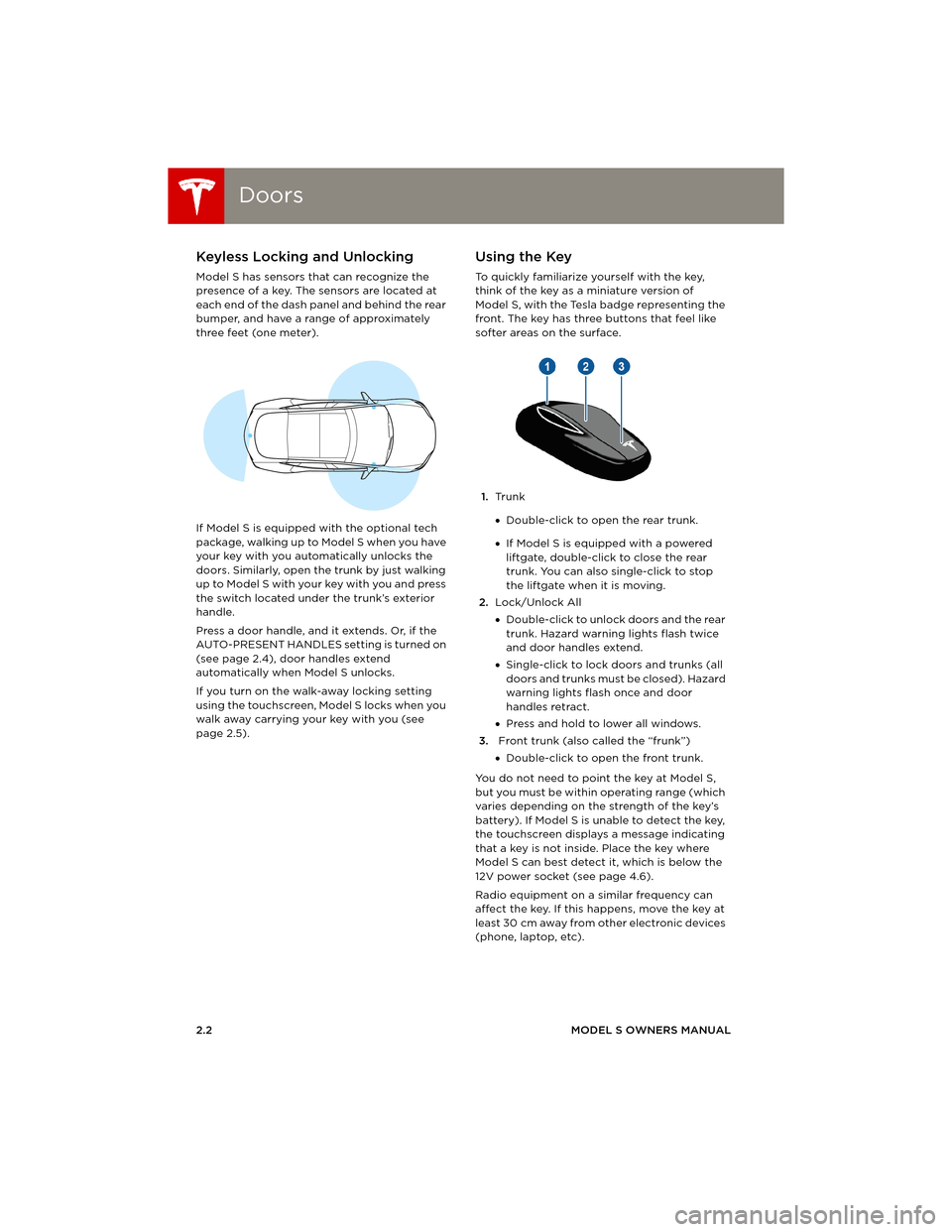
DoorsDoors
2.2MODEL S OWNERS MANUAL
OPENING AND CLOSING
DoorsKeyless Locking and Unlocking
Model S has sensors that can recognize the
presence of a key. The sensors are located at
each end of the dash panel and behind the rear
bumper, and have a range of approximately
three feet (one meter).
If Model S is equipped with the optional tech
package, walking up to Model S when you have
your key with you automatically unlocks the
doors. Similarly, open the trunk by just walking
u p to M o de l S w it h yo ur key w i t h yo u an d p re ss
the switch located under the trunk’s exterior
handle.
Press a door handle, and it extends. Or, if the
AUTO-PRESENT HANDLES setting is turned on
(see page 2.4), door handles extend
automatically when Model S unlocks.
If you turn on the walk-away locking setting
using the touchscreen, Model S locks when you
walk away carrying your key with you (see
page 2.5).
Using the Key
To quickly familiarize yourself with the key,
think of the key as a miniature version of
Model S, with the Tesla badge representing the
front. The key has three buttons that feel like
softer areas on the surface.
1.Tr u n k
•Double-click to open the rear trunk.
•If Model S is equipped with a powered
liftgate, double-click to close the rear
trunk. You can also single-click to stop
the liftgate when it is moving.
2.Lock/Unlock All
•Double-click to unlock doors and the rear
trunk. Hazard warning lights flash twice
and door handles extend.
•Single-click to lock doors and trunks (all
d o o r s a n d t r u n k s m u s t b e c l o s e d ) . H a z a r d
warning lights flash once and door
handles retract.
•Press and hold to lower all windows.
3. Front trunk (also called the “frunk”)
•Double-click to open the front trunk.
You do not need to point the key at Model S,
but you must be within operating range (which
varies depending on the strength of the key’s
battery). If Model S is unable to detect the key,
the touchscreen displays a message indicating
that a key is not inside. Place the key where
Model S can best detect it, which is below the
12V power socket (see page 4.6).
Radio equipment on a similar frequency can
affect the key. If this happens, move the key at
least 30 cm away from other electronic devices
(phone, laptop, etc).
book.book Page 2 Friday, July 19, 2013 12:53 PM
Page 11 of 152
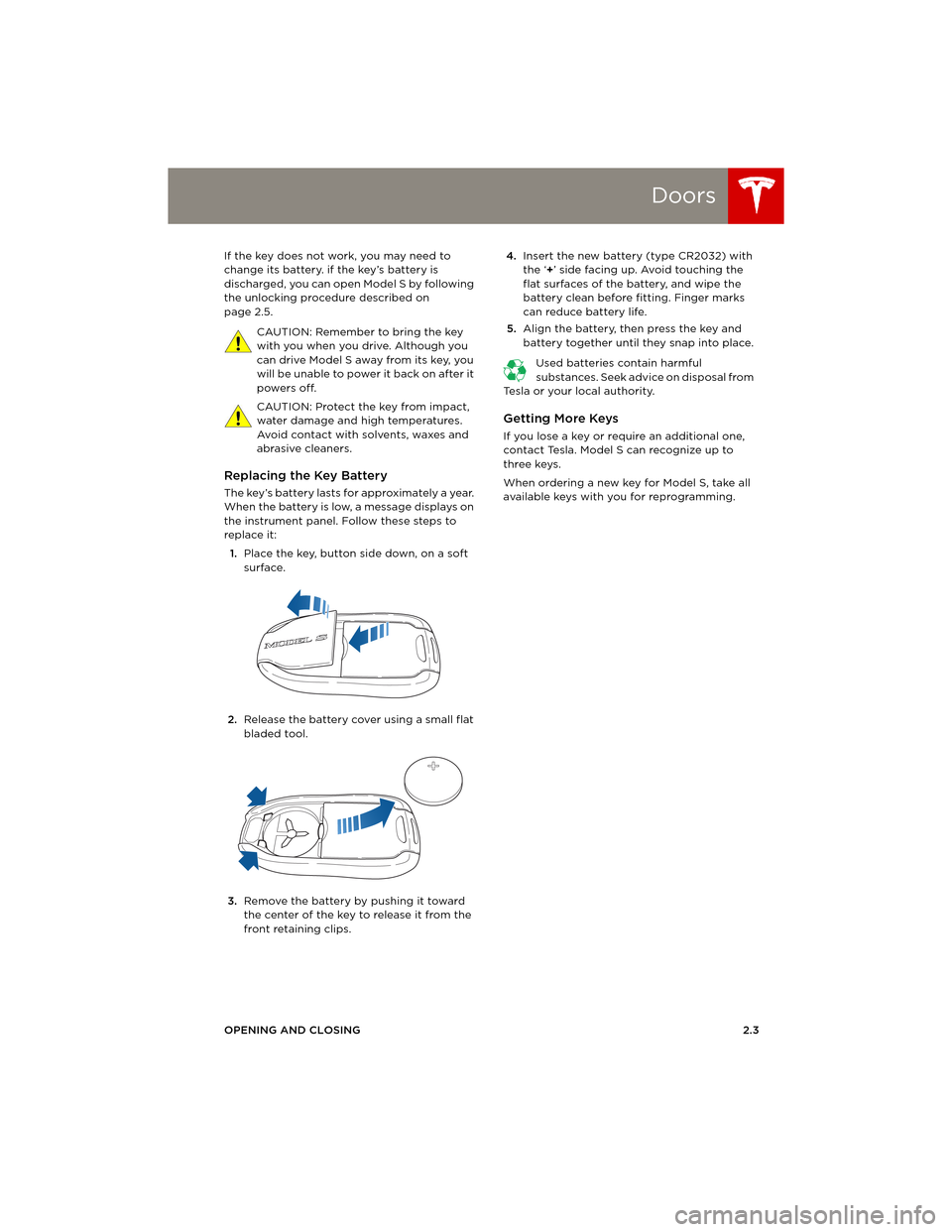
Doors
OPENING AND CLOSING2.3 If the key does not work, you may need to
change its battery. if the key’s battery is
discharged, you can open Model S by following
the unlocking procedure described on
page 2.5.
CAUTION: Remember to bring the key
with you when you drive. Although you
can drive Model S away from its key, you
will be unable to power it back on after it
powers off.
CAUTION: Protect the key from impact,
water damage and high temperatures.
Avoid contact with solvents, waxes and
abrasive cleaners.
Replacing the Key Battery
The key’s battery lasts for approximately a year.
When the battery is low, a message displays on
the instrument panel. Follow these steps to
replace it:
1.Place the key, button side down, on a soft
surface.
2.Release the battery cover using a small flat
bladed tool.
3.Remove the battery by pushing it toward
the center of the key to release it from the
front retaining clips. 4.Insert the new battery (type CR2032) with
the ‘+’ side facing up. Avoid touching the
flat surfaces of the battery, and wipe the
battery clean before fitting. Finger marks
can reduce battery life.
5.Align the battery, then press the key and
battery together until they snap into place.
Used batteries contain harmful
substances. Seek advice on disposal from
Tesla or your local authority.
Getting More Keys
If you lose a key or require an additional one,
contact Tesla. Model S can recognize up to
three keys.
When ordering a new key for Model S, take all
available keys with you for reprogramming.
book.book Page 3 Friday, July 19, 2013 12:53 PM
Page 13 of 152
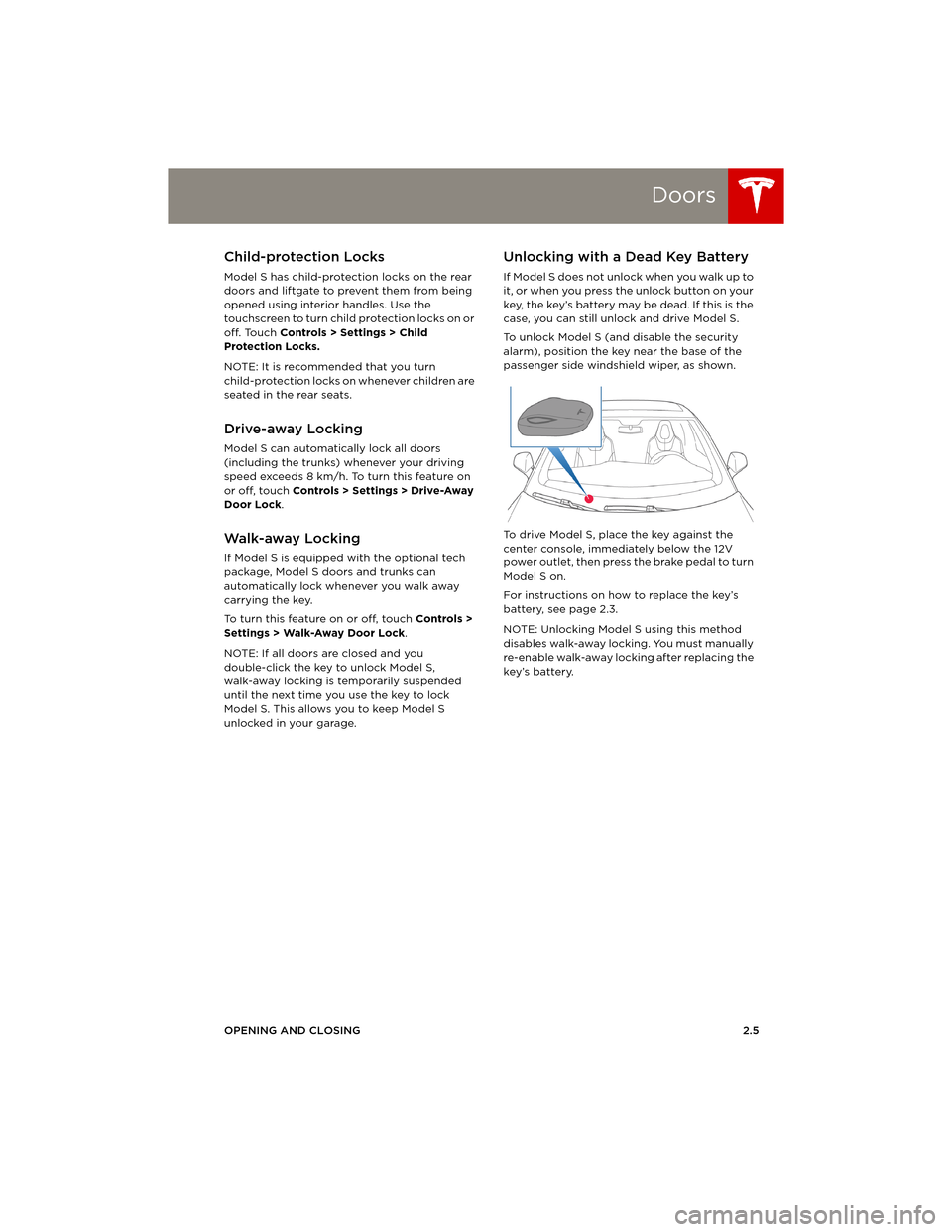
Doors
OPENING AND CLOSING2.5
Child-protection Locks
Model S has child-protection locks on the rear
doors and liftgate to prevent them from being
opened using interior handles. Use the
touchscreen to turn child protection locks on or
off. Touch Controls > Settings > Child
Protection Locks.
NOTE: It is recommended that you turn
child-protection locks on whenever children are
seated in the rear seats.
Drive-away Locking
Model S can automatically lock all doors
(including the trunks) whenever your driving
speed exceeds 8 km/h. To turn this feature on
or off, touch Controls > Settings > Drive-Away
Door Lock.
Walk-away Locking
If Model S is equipped with the optional tech
package, Model S doors and trunks can
automatically lock whenever you walk away
carrying the key.
To turn this feature on or off, touch Controls >
Settings > Walk-Away Door Lock.
NOTE: If all doors are closed and you
double-click the key to unlock Model S,
walk-away locking is temporarily suspended
until the next time you use the key to lock
Model S. This allows you to keep Model S
unlocked in your garage.
Unlocking with a Dead Key Battery
If Model S does not unlock when you walk up to
it, or when you press the unlock button on your
key, the key’s battery may be dead. If this is the
case, you can still unlock and drive Model S.
To unlock Model S (and disable the security
alarm), position the key near the base of the
passenger side windshield wiper, as shown.
To drive Model S, place the key against the
center console, immediately below the 12V
power outlet, then press the brake pedal to turn
Model S on.
For instructions on how to replace the key’s
battery, see page 2.3.
NOTE: Unlocking Model S using this method
disables walk-away locking. You must manually
re-enable walk-away locking after replacing the
key’s battery.
book.book Page 5 Friday, July 19, 2013 12:53 PM
Page 15 of 152

Windows
OPENING AND CLOSING2.7
Wi ndow sOpening from the Exterior
To open windows from outside Model S, press
and hold the unlock button on the key.
Opening and Closing from the
Interior
Press down on a switch to lower the associated
window all the way down. Window switches
operate at two levels. To lower a window
partially, hold the switch and release when the
window is at the desired position.
Similarly, pull a switch to raise the associated
window. This also operates at two levels—when
raising, hold the switch and release when the
window is at the desired position.
WARNING: Before closing a power
window, it is the driver’s responsibility to
ensure that all occupants, especially children,
do not have any body parts extended through
the window’s opening. Failure to do so can
cause serious injury.
WARNING: When leaving Model S, always
take your key with you. Leaving the key in
Model S allows all doors, windows, and controls to be fully operational and can cause
hazardous, unauthorized or unintentional use
of Model S.
Locking Rear Windows
To prevent passengers from using the rear
window switches, press the rear window lock
switch. The switch light turns on. To unlock rear
windows, press the switch again.
WARNING: To ensure safety, it is
recommended that you lock the rear
windows whenever children are seated in the
rear seats.
WARNING: Never leave children
unattended in Model S.
book.book Page 7 Friday, July 19, 2013 12:53 PM
Page 16 of 152
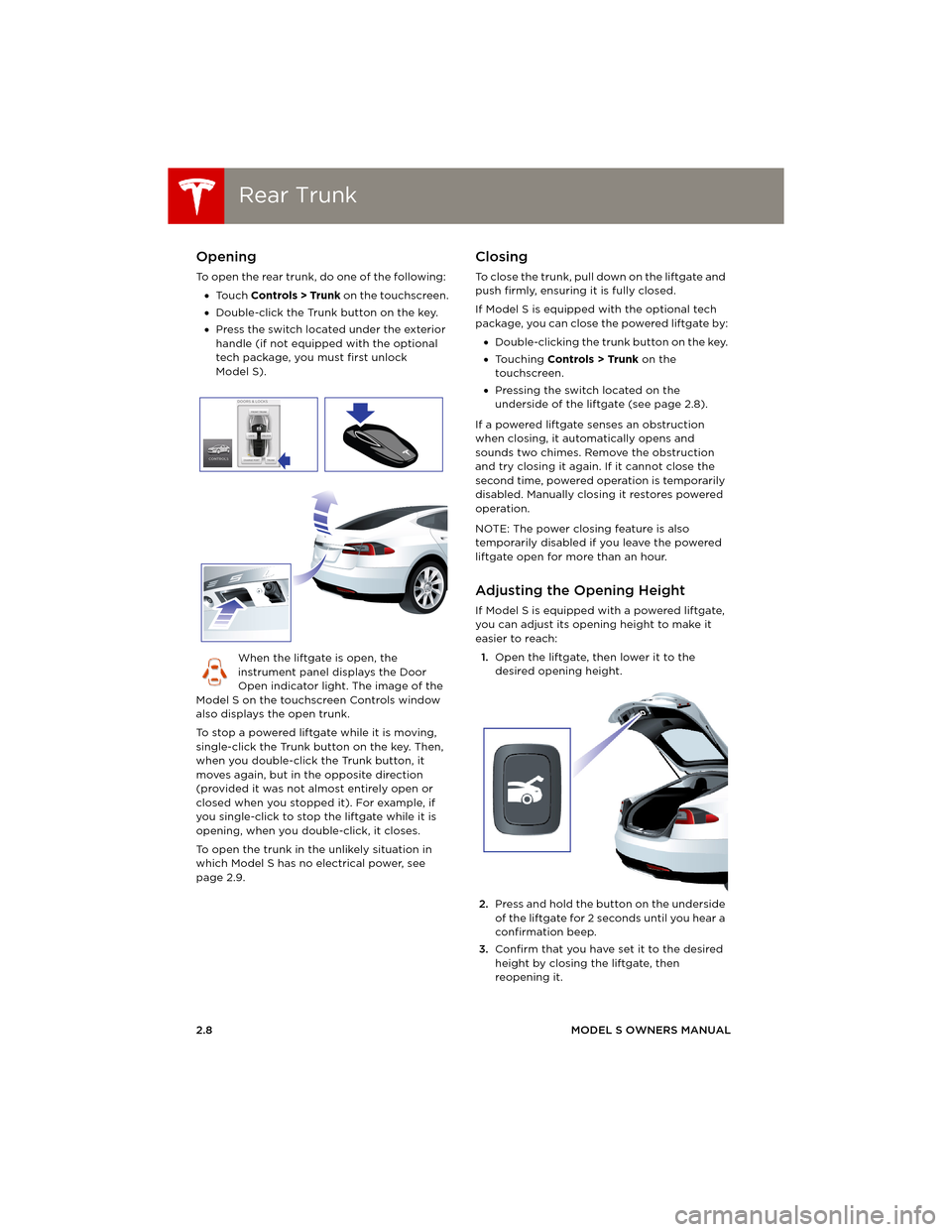
Rear TrunkRear Trunk
2.8MODEL S OWNERS MANUAL
Rear TrunkOpening
To open the rear trunk, do one of the following:
•To u c h Controls > Trunk on the touchscreen.
•Double-click the Trunk button on the key.
•Press the switch located under the exterior
handle (if not equipped with the optional
tech package, you must first unlock
Model S).
When the liftgate is open, the
instrument panel displays the Door
Open indicator light. The image of the
Model S on the touchscreen Controls window
also displays the open trunk.
To stop a powered liftgate while it is moving,
single-click the Trunk button on the key. Then,
when you double-click the Trunk button, it
moves again, but in the opposite direction
(provided it was not almost entirely open or
closed when you stopped it). For example, if
you single-click to stop the liftgate while it is
opening, when you double-click, it closes.
To open the trunk in the unlikely situation in
which Model S has no electrical power, see
page 2.9.
Closing
To close the trunk, pull down on the liftgate and
push firmly, ensuring it is fully closed.
If Model S is equipped with the optional tech
package, you can close the powered liftgate by:
•Double-clicking the trunk button on the key.
•Touching Controls > Trunk on the
touchscreen.
•Pressing the switch located on the
underside of the liftgate (see page 2.8).
If a powered liftgate senses an obstruction
when closing, it automatically opens and
sounds two chimes. Remove the obstruction
and try closing it again. If it cannot close the
second time, powered operation is temporarily
disabled. Manually closing it restores powered
operation.
NOTE: The power closing feature is also
temporarily disabled if you leave the powered
liftgate open for more than an hour.
Adjusting the Opening Height
If Model S is equipped with a powered liftgate,
you can adjust its opening height to make it
easier to reach:
1.Open the liftgate, then lower it to the
desired opening height.
2.Press and hold the button on the underside
of the liftgate for 2 seconds until you hear a
confirmation beep.
3.Confirm that you have set it to the desired
height by closing the liftgate, then
reopening it.
book.book Page 8 Friday, July 19, 2013 12:53 PM
Page 18 of 152

Front TrunkFront Trunk
2.10MODEL S OWNERS MANUAL
Front TrunkOpening
To open the front trunk:
•To u c h Controls > Front Trunk on the
touchscreen, or double-click the front trunk
button on the key.
•Pull the hood up.
The door open indicator displays on the
instrument panel when the front trunk
is open. The image of the Model S on
the touchscreen Controls window also displays
the open trunk.
To open the front trunk in the unlikely situations
where Model S has no electrical power, see
page 2.11.
Closing
Lower the hood, then place both hands on the
front of the hood as shown. Press down firmly
with both hands to engage the latches. Lift the
front edge of the hood to ensure it is fully
closed.
WARNING: Slamming or dropping the
hood can cause damage, and does not
ensure that it is properly closed.
WARNING: Do not drive with the hood
secured by the secondary catch alone.
book.book Page 10 Friday, July 19, 2013 12:53 PM
Page 19 of 152
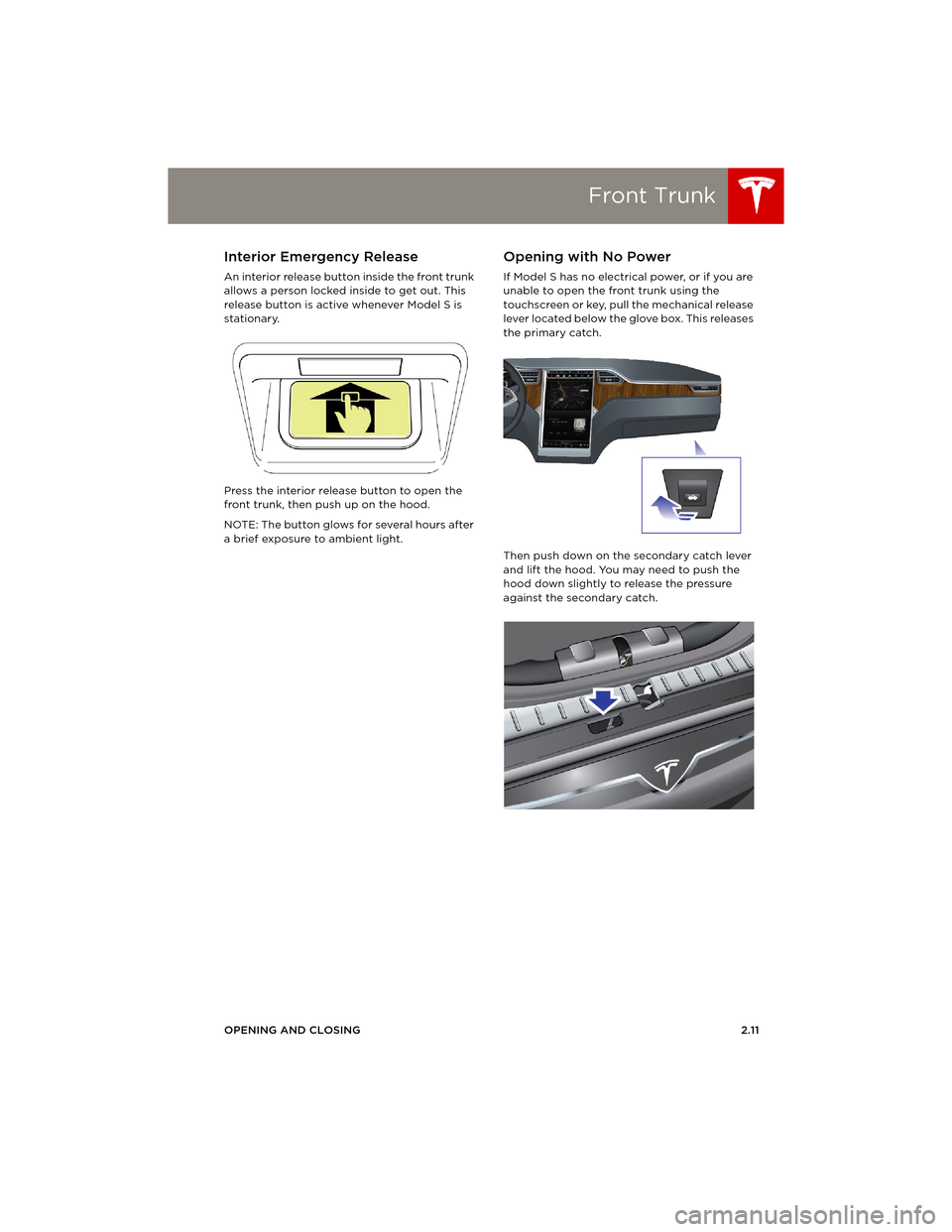
Front Trunk
OPENING AND CLOSING2.11
Interior Emergency Release
An interior release button inside the front trunk
allows a person locked inside to get out. This
release button is active whenever Model S is
stationary.
Press the interior release button to open the
front trunk, then push up on the hood.
NOTE: The button glows for several hours after
a brief exposure to ambient light.
Opening with No Power
If Model S has no electrical power, or if you are
unable to open the front trunk using the
touchscreen or key, pull the mechanical release
lever located below the glove box. This releases
the primary catch.
Then push down on the secondary catch lever
and lift the hood. You may need to push the
hood down slightly to release the pressure
against the secondary catch.
book.book Page 11 Friday, July 19, 2013 12:53 PM
Page 28 of 152

Seat BeltsSeat Belts
3.6MODEL S OWNERS MANUAL
Seat Belt Warnings
WARNING: Seat belts should be worn by
all occupants for every journey no matter
how short. Failure to do so increases the risk of
injury or death if an accident occurs.
WARNING: Secure small children in a
suitable child safety seat (see page 3.7).
Always follow the child safety seat
manufacturer's instructions when installing.
WARNING: Ensure that all seat belts are
worn correctly. An improperly worn seat
belt increases the risk of injury or death if an
accident occurs (see page 3.4).
WARNING: Do not wear seat belts over
hard, fragile or sharp items in clothing,
such as pens, keys, eyeglasses, etc. The
pressure from the seat belt on such items can
cause injury.
WARNING: Seat belts should not be worn
with any part of the strap twisted.
WARNING: Each seat belt assembly must
be used by one occupant only. It is
dangerous to put a seat belt around a child
being carried on an occupant’s lap.
WARNING: Seat belts that have been
w o r n i n a n a c c i d e n t m u s t b e i n s p e c t e d o r
replaced by Tesla, even if damage to the
assembly is not obvious.
WARNING: Seat belts that show signs of
wear (such as fraying) or have been cut
or damaged in any way, must be replaced by
Te s l a .
WARNING: Avoid contaminating a seat
belt’s components with any chemicals,
liquids, grit, dirt or cleaning products. If a seat
belt fails to retract or latch into the buckle, it
must be replaced immediately. Contact Tesla.
WARNING: Do not make modifications or
additions that can prevent a seat belt
mechanism from taking up slack, or that can
prevent a seat belt from being adjusted to
remove slack. A slack belt greatly reduces
occupant protection.
WARNING: Do not make modifications
that can interfere with the operation of a
seat belt, or that can cause a seat belt to
become inoperable. WARNING: When seat belts are not in
use, they should be fully retracted and
not hanging loose. If a seat belt does not fully
retract, contact Tesla.
book.book Page 6 Friday, July 19, 2013 12:53 PM
Page 29 of 152
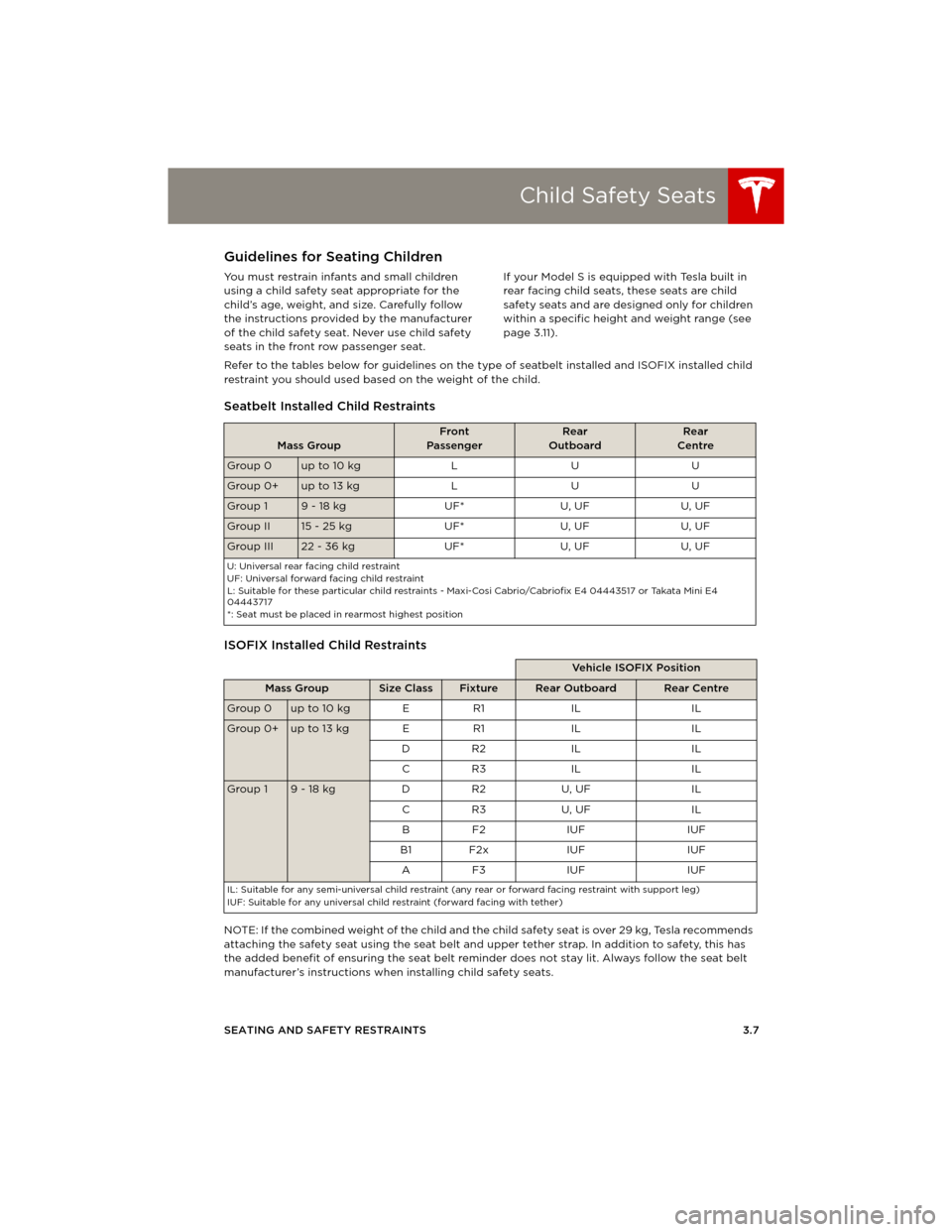
Child Safety Seats
SEATING AND SAFETY RESTRAINTS 3.7
Child Safety SeatsGuidelines for Seating Children
You must restrain infants and small children
using a child safety seat appropriate for the
child’s age, weight, and size. Carefully follow
the instructions provided by the manufacturer
of the child safety seat. Never use child safety
seats in the front row passenger seat. If your Model S is equipped with Tesla built in
rear facing child seats, these seats are child
safety seats and are designed only for children
within a specific height and weight range (see
page 3.11).
Refer to the tables below for guidelines on the type of seatbelt installed and ISOFIX installed child
restraint you should used based on the weight of the child.
Seatbelt Installed Child Restraints
ISOFIX Installed Child Restraints
NOTE: If the combined weight of the child and the child safety seat is over 29 kg, Tesla recommends
attaching the safety seat using the seat belt and upper tether strap. In addition to safety, this has
the added benefit of ensuring the seat belt reminder does not stay lit. Always follow the seat belt
manufacturer’s instructions when installing child safety seats.
Mass GroupFront
PassengerRear
OutboardRear
Centre
Group 0up to 10 kg L U U
Group 0+up to 13 kg L U U
Group 19 - 18 kg UF* U, UF U, UF
Group II15 - 25 kg UF* U, UF U, UF
Group III 22 - 36 kg UF* U, UF U, UF
U: Universal rear facing child restraint
UF: Universal forward facing child restraint
L: Suitable for these particular child restraints - Maxi-Cosi Cabrio/Cabriofix E4 04443517 or Takata Mini E4
04443717
*: Seat must be placed in rearmost highest position
Vehicle ISOFIX Position
Mass GroupSize ClassFixtureRear OutboardRear Centre
Group 0up to 10 kg E R1 IL IL
Group 0+up to 13 kg E R1 IL IL
DR2 IL IL
CR3 IL IL
Group 19 - 18 kg D R2 U, UF IL
CR3 U, UF IL
BF2 IUF IUF
B1 F2x IUF IUF
AF3 IUF IUF
IL: Suitable for any semi-universal child restraint (any rear or forward facing restraint with support leg)
IUF: Suitable for any universal child restraint (forward facing with tether)
book.book Page 7 Friday, July 19, 2013 12:53 PM
Page 32 of 152
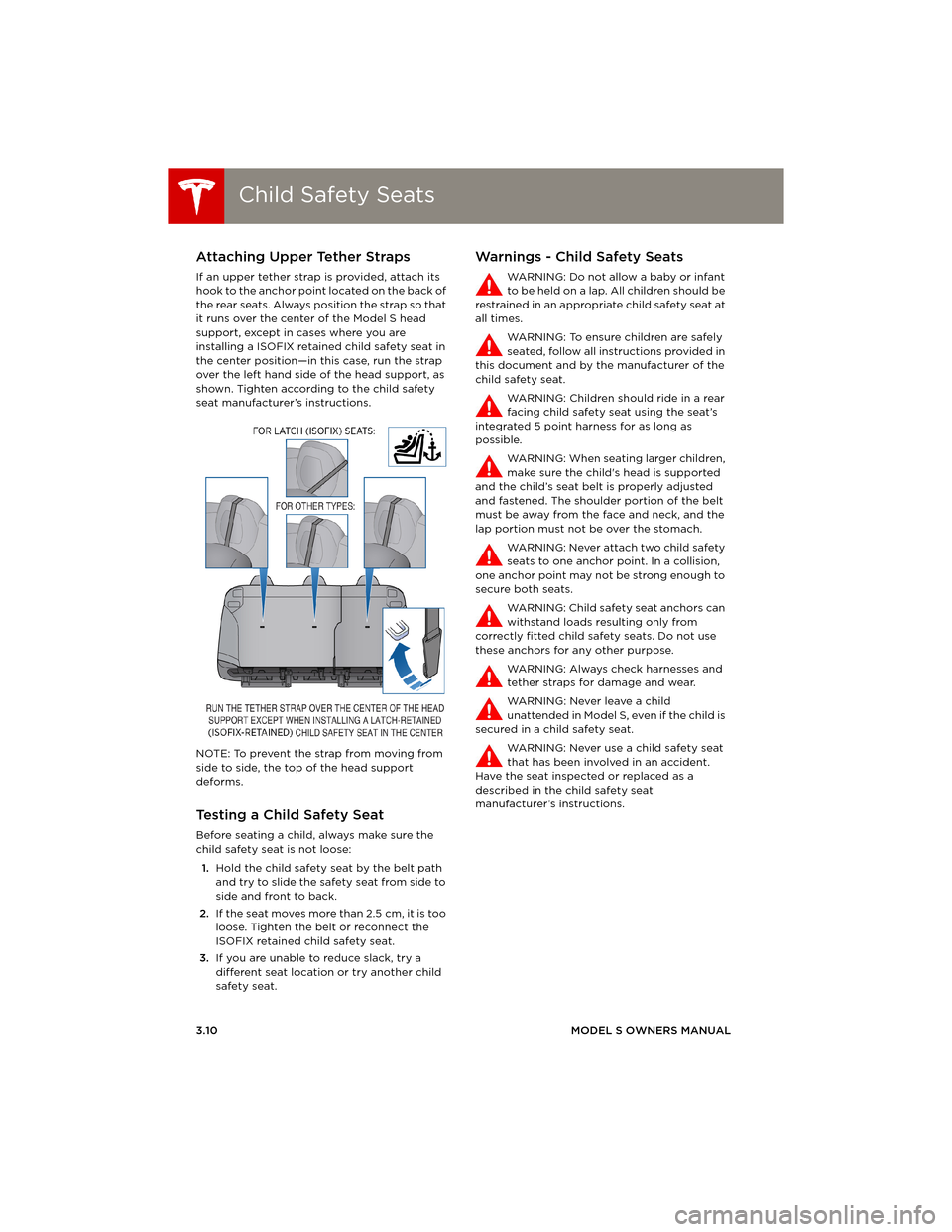
Child Safety SeatsChild Safety Seats
3.10MODEL S OWNERS MANUAL
Attaching Upper Tether Straps
If an upper tether strap is provided, attach its
hook to the anchor point located on the back of
the rear seats. Always position the strap so that
it runs over the center of the Model S head
support, except in cases where you are
installing a ISOFIX retained child safety seat in
the center position—in this case, run the strap
over the left hand side of the head support, as
shown. Tighten according to the child safety
seat manufacturer’s instructions.
NOTE: To prevent the strap from moving from
side to side, the top of the head support
deforms.
Testing a Child Safety Seat
Before seating a child, always make sure the
child safety seat is not loose:
1.Hold the child safety seat by the belt path
and try to slide the safety seat from side to
side and front to back.
2.If the seat moves more than 2.5 cm, it is too
loose. Tighten the belt or reconnect the
ISOFIX retained child safety seat.
3.If you are unable to reduce slack, try a
different seat location or try another child
safety seat.
Warnings - Child Safety Seats
WARNING: Do not allow a baby or infant
to be held on a lap. All children should be
restrained in an appropriate child safety seat at
all times.
WARNING: To ensure children are safely
seated, follow all instructions provided in
this document and by the manufacturer of the
child safety seat.
WARNING: Children should ride in a rear
facing child safety seat using the seat’s
integrated 5 point harness for as long as
possible.
WARNING: When seating larger children,
make sure the child's head is supported
and the child’s seat belt is properly adjusted
and fastened. The shoulder portion of the belt
must be away from the face and neck, and the
lap portion must not be over the stomach.
WARNING: Never attach two child safety
seats to one anchor point. In a collision,
one anchor point may not be strong enough to
secure both seats.
WARNING: Child safety seat anchors can
withstand loads resulting only from
correctly fitted child safety seats. Do not use
these anchors for any other purpose.
WARNING: Always check harnesses and
tether straps for damage and wear.
WARNING: Never leave a child
unattended in Model S, even if the child is
secured in a child safety seat.
WARNING: Never use a child safety seat
that has been involved in an accident.
Have the seat inspected or replaced as a
described in the child safety seat
manufacturer’s instructions.
book.book Page 10 Friday, July 19, 2013 12:53 PM